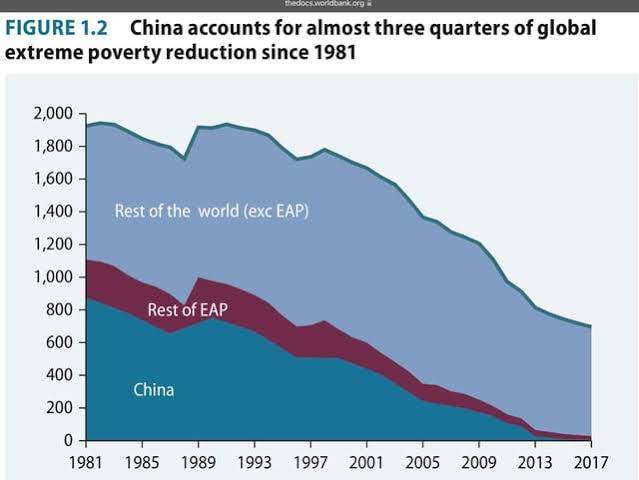this post was submitted on 20 Jun 2024
62 points (100.0% liked)
China
2032 readers
21 users here now
Discuss anything related to China.
Community Rules:
0: Taiwan, Xizang (Tibet), Xinjiang, and Hong Kong are all part of China.
1: Don't go off topic.
2: Be Comradely.
3: Don't spread misinformation or bigotry.
讨论中国的地方。
社区规则:
零、台湾、西藏、新疆、和香港都是中国的一部分。
一、不要跑题。
二、友善对待同志。
三、不要传播谣言或偏执思想。
founded 4 years ago
MODERATORS
you are viewing a single comment's thread
view the rest of the comments
view the rest of the comments

(Figure 1: Simple Area chart)
After doing the math (below) and calculating the absolute values ONLY by using what was provided in the graph by OurWorldInData (pixel counting), I can get the above graph. I used a simple area chart for Figure 1 because it's close in content and character to what they posted. The reason the left side of Figure 1 appears proportionally different to theirs is because their Y-axis is %, mine is an absolute value. The world population Changed which is not captured in their graph, but is captured in mine. A "simple" area chart is effectively a line chart, as each individual point is with reference to 0, and is therefore it is not suitable to showcase a relationship of each individual part to a whole over time.
Figure 1 can also be represented as Figure 2 simply by subtracting the two quantities to calculate for "Only China" and switching to a stacked area chart. A stacked area chart is what is used in the OP, and it is used to show relationships between two different quantities and also their relationship to the whole over time. On the contrary, a line chart/"simple" area chart is better used to look at different quantities in isolation.
(Figure 2: Stacked Area chart)
So, using ONLY their graph, and converting it to absolute values, we get basically the same graph as in the OP (only with 2 points over time instead of however many there are in the full dataset).
In effect, they're using two clever tricks in the OurWorldInData graph - one trick is that they calculate from the perspective of World and World-minus-China and use a line chart two draw an equivalence between them. Another trick is that they use Share of Population (%) as the Y-axis, which is inherently problematic for comparisons, as (a) the world population changed (b) the chinese population stayed basically the same. This means that although the share might decrease, the absolute value (the raw number of people in extreme poverty) may stay the same (or even increase! though it didn't), and finally (c) it's easier for people to conceptualize an absolute count of individuals who were lifted out of poverty rather than thinking of percentages of population.
Their conclusion is that China was not solely responsible for poverty alleviation. No shit. Even the OP says China accounts "only" for 75% of world poverty alleviation, and uses $1.90 as benchmark for extreme poverty whereas this uses $2.15. If we do the math, using their benchmark and their data, China accounted for 62% of poverty alleviation.
For a website called OurWorldInData, they sure can't represent data for shit.
Math
By pixel counting, the graph says extreme poverty (below $2.15) in the...World 2022 8.983%
World minus China 2022 10.913%
World 1990 37.992%
World minus China 1990 28.726%
Then...
World population in 1990
- 5.293 billion (5,293,000,000)
China population in 1990
- 1.135 billion (1,135,000,000)
World population without China in 1990
- 4.158 billion (4,158,000,000)
World population in 2022
- 7.951 billion (7,951,000,000)
China population in 2022
- 1.412 billion (1,412,000,000)
World population without China in 2022
- 6.539 billion (6,539,000,000)
Absolute values for extreme poverty (below $2.15) in the...
World 2022...........................................714,238,330
China 2022....................................................637,260
World minus China 2022.................713,601,070
World 1990........................................2,010,916,560
China 1990............................................816,489,490
World minus China 1990..............1,194,427,080
This also matches the graph in the OP. By pixel counting the world-minus-china has 1195 million in 1990, which is what we got, and 701 million in 2017 which is close to what we got. The differences can be explained by the fact that the OurWorldInData graph goes to 2022 and that they define extreme poverty by $2.15 whereas OP's WorldBank goes by $1.90.
Wow, great work! That's pretty much what i intuitively expected was the case when i looked a bit into how they were representing the data in their graph and what the World Bank source actually says.
I also went ahead and tried to see what changes if you use a higher poverty line, like something around $5 for instance, and it turns out that in this case we may actually have an increase in total number of people in poverty if you exclude China. Whichever metric you use, it is indisputable that China has done something no one else in the world has managed to do.